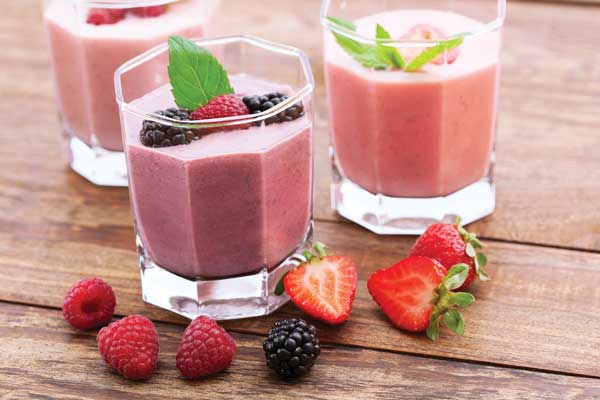Weighty Matters
NUTRACEUTICALS
Weight loss and weight management are long-standing concerns for a large portion of the population. According to the World Health Organization, in 2016, 39% of adults aged 18 years and older were overweight, and 13% were obese. In addition, 41 million children under the age of 5 were overweight or obese, and more than 340 million children and adolescents aged 5–19 were overweight or obese in 2016.
 “For some time now, the trend in weight management has focused more on eating healthy foods and following a balanced diet, while there’s been a movement away from starvation,” observes Megan De Stefano, probiotics global marketing leader at DuPont Nutrition & Health. “Today’s diet is about feeling full and healthy, which is contrary to yesterday’s diet, which was about feeling deprived. Personalization is also a trend in today’s diets. More interest is also being shown toward cleanse-type diets to help people who want to stop craving certain foods and get on track for eating well.”
“For some time now, the trend in weight management has focused more on eating healthy foods and following a balanced diet, while there’s been a movement away from starvation,” observes Megan De Stefano, probiotics global marketing leader at DuPont Nutrition & Health. “Today’s diet is about feeling full and healthy, which is contrary to yesterday’s diet, which was about feeling deprived. Personalization is also a trend in today’s diets. More interest is also being shown toward cleanse-type diets to help people who want to stop craving certain foods and get on track for eating well.”
Today’s popular diets include Paleo, ketogenic, alkaline, and Mediterranean. Paleo includes lean meats, fish, fruits, vegetables, nuts, and seeds, but avoids grains such as wheat, oats, and barley, legumes, dairy products, refined sugar, and highly processed foods. The ketogenic diet focuses on high fat, high protein, and less carbohydrates. The alkaline diet strives to make the body more alkaline by promoting fruits, vegetables, soybeans, tofu, some nuts, seeds, and legumes. The Mediterranean diet emphasizes plant foods (fruits, beans, nuts, whole grains, seeds, and olive oil), cheese and yogurt as dairy foods, moderate amounts of fish and poultry, and small amounts of red meat.
Lean proteins are promoted in these and other weight loss and management programs. Protein from whey and egg are still sought after, but plant proteins continue to grow in popularity as more consumers try to incorporate plant-based eating in their diets. This has brought about the growing interest in alternative proteins like pea, soy, rice, and seed proteins. Here is a look at some other ingredients that can be part of weight management plans.
Dietary Fiber
Dietary fiber contributes to wellness by benefiting heart and digestive health. Regarding weight, dietary fiber can help promote satiety and keep blood sugar in a healthy range.
 “Many weight management products are being reformulated as consumers continue to seek out clean labels, fewer added sugars and better-for-you foods and beverages. Typically, these products already highlight fiber due to its nutritional benefits,” says Doris Dougherty, Fibersol technical service representative at ADM. “Reformulation work can often include a rebalancing and repositioning to reduce sugar and calories of existing products. Product developers are also relying on fiber to create products that have an added benefit of aiding satiety.”
“Many weight management products are being reformulated as consumers continue to seek out clean labels, fewer added sugars and better-for-you foods and beverages. Typically, these products already highlight fiber due to its nutritional benefits,” says Doris Dougherty, Fibersol technical service representative at ADM. “Reformulation work can often include a rebalancing and repositioning to reduce sugar and calories of existing products. Product developers are also relying on fiber to create products that have an added benefit of aiding satiety.”
Through a joint venture with Matsutani LLC, ADM offers the Fibersol line of soluble, highly functional dietary fiber (digestion-resistant maltodextrin) that offers multiple benefits for weight management formulators. Each gram of Fibersol-2 is 90% fiber and provides only 0.02 g of sugar and 1.6 Kcal.
“A study with Iowa State University indicated that Fibersol can provide an increased feeling of satiety, leaving consumers feeling fuller for longer periods of time, and 10 g of Fibersol with a meal can increase certain satiety hormones and delay feeling hungry,” explains Dougherty. “Subjects who consumed soluble fiber in the form of Fibersol-2 not only experienced prolonged fullness and delayed post-meal hunger compared to those consuming a placebo, they also increased production of the satiety hormones PYY and GLP-1.”
Ingredion offers a satiety ingredient made from a proprietary high-amylose resistant starch, whole grain, hydrocolloid, and unique composite technology. WEIGHTAIN suppresses the hunger urge and can reduce calorie intake by about 50–100 calories per day. O’Connor and Campbell (2016) demonstrated that the satiety ingredient also significantly lowered both post-breakfast and post-lunch glycemic and insulin responses relative to the control. The study also showed that WEIGHTAIN was clinically effective when incorporated into two different food applications, a frozen berry smoothie and cold-pressed bars.
Probiotics
“Some of the mainstay products in weight management are high protein and high fiber. Both are viewed as healthy ways to keep you feeling full,” says De Stefano. “There are other ingredients often used in weight management supplements like green tea extract. And, there are newer ingredients, like probiotics, which have demonstrated clinical science to support that certain strains, like Bifidobacterium lactis B420, exclusively from DuPont, can support weight management.”
DuPont Nutrition & Health launched HOWARU Shape last year, a probiotic formula that contains 10 billion CFU of Bifidobacterium lactis B420. The probiotic was shown to support weight management in multiple ways, including controlling body fat mass, reducing calorie intake, and helping consumers manage their waist size. Stenman et al. (2016) demonstrated that subjects who took HOWARU Shape in combination with 12 g of DuPont’s Litesse Ultra prebiotic fiber had a one-inch smaller waist circumference, and less body fat mass and trunk fat compared to those who took the placebo. The study was conducted with 225 healthy subjects.
“We saw these results in the groups taking B420 (either alone or in combination with Litesse Ultra prebiotic fiber compared to groups not taking B420). In the study, consumers were asked not to change their diet or exercise routine, and we still saw these fantastic results. In addition to this study, Litesse has clinical study results showing it controls appetite and decreases after-meal feelings of hunger,” says De Stefano.
Nuts
“Current weight management trends point to a demand for healthier snacking options that are high in protein and fiber content, are portable, satiating, and can be ‘customized’ to individual tastes and preferences,” says Jeff Smith, director of marketing at Blue Diamond Almonds Global Ingredients Division. “Almonds check all of these boxes, which is why they continue to be an important ingredient in weight management foods and diet plans.”
“At Blue Diamond, we also see the impact of programs like Whole30 and the desire for clean label ingredients as factors in weight management trends. We are still benefiting from consumers’ interest in ‘better for you’ snack foods, including as meal replacements,” he observes. “Almonds are considered a good fit with many popular weight loss or weight management plans because they provide excellent satiety, plentiful nutrients per calorie, and great flavor and crunch.”
Almonds are high in six essential nutrients per ounce: protein (6 g), fiber (4 g), calcium (75 mg), vitamin E (7.4 mg), riboflavin (0.3 mg), and niacin (1 mg). Almonds also have 4 g of fiber/oz, which provides both energy and lasting satisfaction. “In addition, researchers are continuing to explore the factors impacting satiety as a strategy to enhance weight management,” adds Smith. “For example, a randomized clinical study in 32 healthy adult women published in the European Journal of Nutrition found that a midmorning snack of almonds helped control appetite and resulted in reduced calorie intake during the rest of the day.”
Pistachios are a source of many essential vitamins and minerals, monounsaturated and polyunsaturated fatty acids, protein, and fiber. Hernandez et al. (2012) suggested that short-term consumption of a pistachio nut snack can decrease body weight and fat as compared to a refined carbohydrate snack in young, healthy adults.
Walnuts are unique among nuts because they are primarily comprised of polyunsaturated fatty acids (PUFAs) and contain a significant amount of plant-based omega-3 alpha-linolenic acid (2.5 g/oz). Stevenson et al. (2017) showed that a PUFA-rich diet consumed for 7 days favorably altered fasting and postprandial physiological markers of hunger and satiety yet did not alter subjective ratings of hunger or fullness. The PUFA-rich diet (21% polyunsaturated fat, 9% monounsaturated fat, and 5% saturated fat) included whole foods such as walnuts, Alaska salmon, tuna, flaxseed oil, grapeseed oil, canola oil, and fish oil supplements.
Allulose and Isomaltulose
Produced through an enzymatic conversion of fructose through a proprietary process, Astraea allulose from Matsutani Chemical Industry Co. was recently shown to enhance postprandial fat oxidation in healthy humans, indicating that it could be a novel sweetener to control and maintain healthy body weight, probably through enhanced energy metabolism. Kimura et al. (2017) conducted the study with 13 healthy men and women. At 30 minutes after taking 5 g of d-allulose or 10 mg of aspartame without any sugar as a control, the subjects who fasted overnight ingested a standardized meal. Then the researchers evaluated energy metabolism. After evaluating the subjects who took d-allulose, the researchers’ results showed that the area under the curve of fat oxidation was significantly higher than those in the control group, whereas that of carbohydrate oxidation was significantly lower.
 “Weight control is managed by the suppression of energy intake and increased energy consumption. Allulose acts on both sides,” explains Tetsuo Iida, manager of rare sugar R&D at Matsutani Chemical Industry Co. “Allulose has only 0.2 calories/g compared to the 4 calories/g of sugar. Because allulose is 70% as sweet, food and beverage manufacturers are able to reduce calorie intake without compromising sweetness,” explains Iida. Most recently, Iwasaki et al. (2018) indicated that allulose induces GLP-1 release, reduces food intake, and promotes glucose tolerance in healthy and obese-diabetic animal models.
“Weight control is managed by the suppression of energy intake and increased energy consumption. Allulose acts on both sides,” explains Tetsuo Iida, manager of rare sugar R&D at Matsutani Chemical Industry Co. “Allulose has only 0.2 calories/g compared to the 4 calories/g of sugar. Because allulose is 70% as sweet, food and beverage manufacturers are able to reduce calorie intake without compromising sweetness,” explains Iida. Most recently, Iwasaki et al. (2018) indicated that allulose induces GLP-1 release, reduces food intake, and promotes glucose tolerance in healthy and obese-diabetic animal models.
Palatinose from BENEO, also generically known as isomaltulose, is a sugar that is slowly taken up by the body. It is derived from sugar beet and consists of one glucose unit and one fructose unit. While sugar has an alpha-1-2 glucosidic bond, Palatinose has an alpha-1-6 glucosidic bond, which is broken down more slowly by digestive enzymes. It has been shown to induce a low blood glucose response. In addition, Palatinose has been shown to increase fat oxidation (König et al. 2012). In obese subjects with insulin resistance and metabolic syndrome, the partial substitution of carbohydrates with Palatinose resulted in greater postprandial fat oxidation at rest and during physical activity.
Saffron
PLT Health Solutions offers a satiety ingredient derived from saffron. Satiereal is derived from the flowers of saffron crocus, Crocus sativus L., and is made from a special crocus cultivation rich in active saffron constituents. Satiereal has been shown to act on serotonin, a neurotransmitter that plays a role in satiety and appetite. Gout et al. (2010) showed that Satiereal may increase satiety, decrease hunger, reduce sugar cravings and reduce compulsive snacking between meals.
Next month’s Nutraceuticals column will discuss ingredients important to bone and joint health.
www.ift.org
Members Only: Read more about ingredients that may aid weight management at ift.org. Type the keywords into the search box at the upper right side of the home page.
 Linda Milo Ohr,
Linda Milo Ohr,
Contributing Editor
Denver, Colo.
[email protected]
References
Gout, B., C. Bourges, and S. Paineau-Dubreuil. 2010. “Satiereal, a Crocus sativus L Extract, Reduces Snacking and Increases Satiety in a Randomized Placebo-controlled Study of Mildly Overweight, Healthy Women.” Nutr. Res. 30: 305–313.
Hernandez, L. M., N. E., Meichtry, D. Soto, et al. 2012. “The Effects of Consuming a Pistachio Snack Versus a Refined Carbohydrate Snack on Blood Lipids, Blood Glucose, Body Weight, and Body Composition in Young, Healthy Adults.” FASEB J. 26(1): Supp. 1.
Iwasaki, Y., M. Sendo, K. Dezaki, et al. 2018. “GLP-1 Release and Vagal Afferent Activation Mediate the Beneficial Metabolic and Chronotherapeutic effects of D-allulose.” Nature Commun. 9: Article Number 113.
Kimura, T., A. Kanasaki, N. Hayashi, et al. 2017. “d-Allulose Enhances Postprandial Fat Oxidation in Healthy Humans.” Nutrition. 43–44: 16–20.
König, D., S. Theis, G. Kozianowski, and A. Berg. 2012. “Postprandial Substrate Use in Overweight Subjects with the Metabolic Ingestion.” Nutrition. 28(6): 651–656.
O’Connor, L. E. and W. W. Campbell. 2016. “A Novel Fiber Composite Ingredient Incorporated into a Beverage and Bar Blunts Postprandial Serum Glucose and Insulin Responses: A Randomized Controlled Trial.” Nutr. Res. 36(3): 253–261.
Stenman, L. K., M. J. Lehtinen, N. Meland, et al. 2016. “Probiotic With or Without Fiber Controls Body Fat Mass, Associated with Serum Zonulin, in Overweight and Obese Adults—Randomized Controlled Trial.” EBioMedicine. 13: 190–200.
Stevenson, J. L., C. M. Paton, and J. A. Cooper. 2017. “Hunger and Satiety Responses to High-fat Meals after a High-Polyunsaturated Fat Diet: A Randomized Trial.” Nutr. 41: 14–23.


